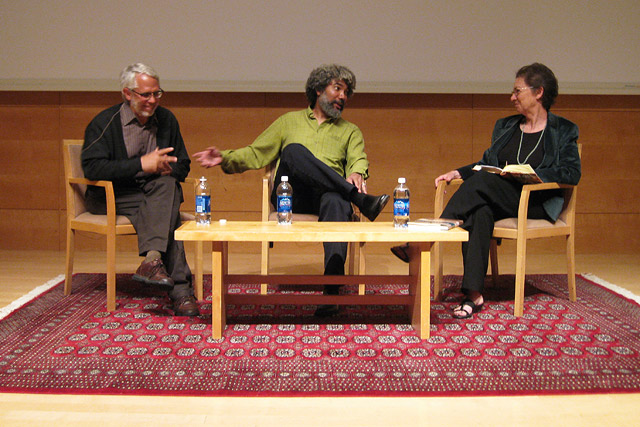
Provocateurs? David Wilson (left) and Fred Wilson (center), with Selma Holo
Education is at the heart of a museum’s mission. You want to know what you’re looking at, and we want to tell you—through object labels, audio tours, videos, brochures, Web sites, and public programs.
But is this really education? Not according to David Wilson, director of the brilliant and baffling Museum of Jurassic Technology (MJT), a modern-day cabinet of wonder that takes an unorthodox approach: valuing experience over knowledge, perplexity over certainty. Some visitors laugh at Wilson’s exhibits. Others storm out. Still others blot their names from the guest book after seeing what he’s put on display.
Wilson doesn’t mind, and not because he’s indifferent to his audience. On the contrary, he respects us so much that he’s delighted with whatever we take away.
“A museum is a place of the muses, a place to be inspired,” he said while visiting the Getty last week for Museum Matters, an occasional series co-organized by the Museum’s Education Department and the International Museum Studies Institute (IMI) at USC. “And I’ve realized that the step from muse to amuse is a short one. We don’t have a clue what they’re laughing at, but it’s hard to argue with laughter.”
In a rousing discussion moderated by IMI director Selma Holo, David Wilson and artist Fred Wilson, who unearths and juxtaposes objects from museums’ deep storage to uncover their hidden stories, debated the place of audience, community, and education in museums.
For both Wilsons, talking about audience and education can lead to sloppy thinking. “I’m not interested in Audience with a capital A,” said Fred Wilson. “A museum is about individual and personal experience. It communicates something different to everyone. The museum is thinking about the ‘audience,’ but is it thinking about me”?
But what about the enormous diversity of museum visitors in age, socioeconomic status, and previous experience of museums?, asked an audience member. Don’t we need education to get our message across?
“We don’t have a message,” replied David Wilson, with zero trace of irony. (Quickly adding, however, “Everything I say I can, of course, argue against.”) “We want to set up conditions to allow people to have their own experience. What I loved about museums as a kid was the experience of the place, its physicalness. A museum is a place where you can have an experience unique to yourself, where you can go to be put in touch with yourself.”
Picking up the theme, Fred Wilson issued a challenge to all of us in the room: “Your job is to understand who you are. If you don’t know who you are, how are you going to know who anybody else is?”
And even if a museum wanted to educate, to convey facts, it’s unclear if it actually should. Or could. “Museums are not the most effective way to communicate knowledge,” noted David Wilson gently.
At last Selma Holo expressed what many of us who labor over labels, audio tours, Web sites, and brochures were secretly wondering: “Isn’t that a provocation to those of us who think we have to be always explaining, explaining, explaining?”
It was a provocation—the two had been playfully introduced as provocateurs, and though both were gracious and deeply thoughtful, their ideas were meant to challenge. “I don’t want labels or audio in my installations,” elaborated Fred Wilson. “You can give people all of this information, and they can start grazing—and stop thinking.”
“What we put into the world is only half the picture,” continued David Wilson. By the end the two were finishing each other’s thoughts. “We know better, at this point, finally, than to control the experience people are going to have. If you pull the rug out from people altogether, they go into freefall. It’s quite remarkable.”




When I visited MJT, it was very inspiring, but it also struck me as intentionally ironic, as if to satirize the way that museums typically display exhibits. Did David Wilson comment on that?
Hi Michael — Good question. I’ve had similar thoughts when visiting the MJT. David Wilson said that the MJT is not intended as a critique of the museum as an institution, and he spoke about his great love for “anachronistic” museums, especially those devoted to science and natural history. However, he also mentioned that the MJT deliberately plays with people’s expectations (“when expectations crack, it’s a wonderful thing”). My sense is that he wants us to figure out our own truth. As for what his truth is, I won’t dare to say!